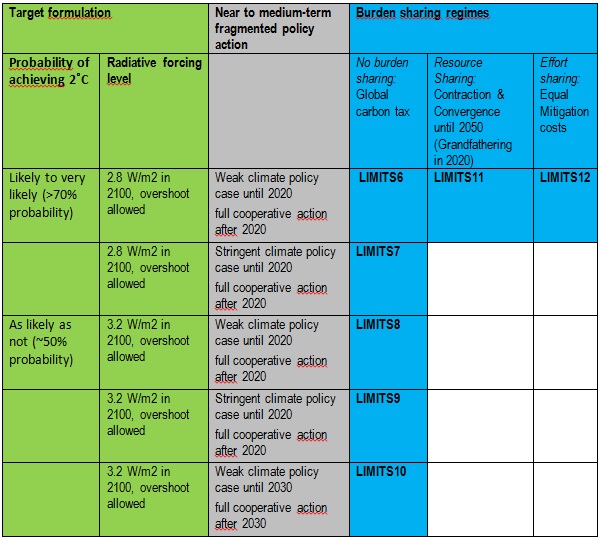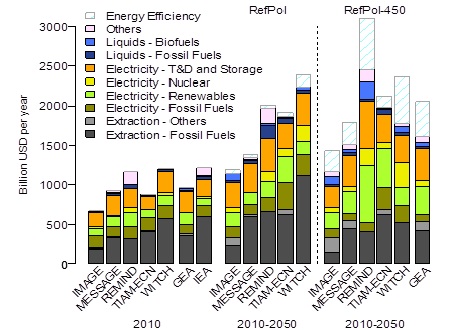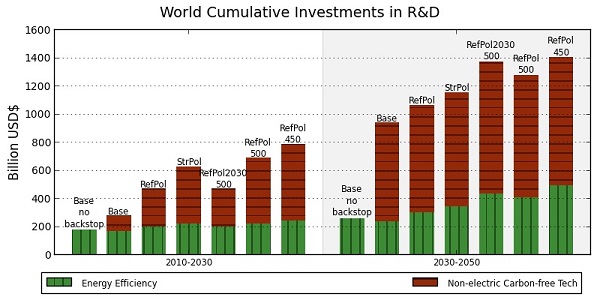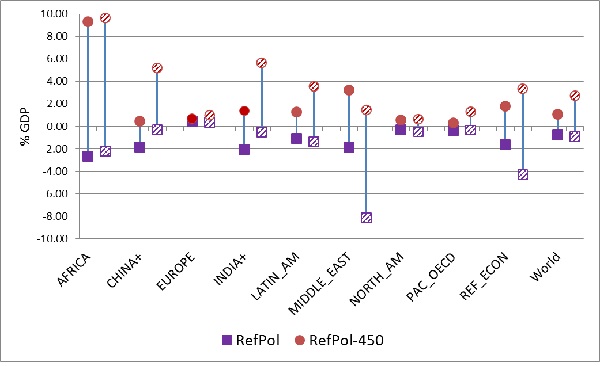From Month 10 (July 2012) to Month 18 (March 2013)
WP1: Global mitigation pathways for limiting global temperature increase below 2°C
The major aim of WP1 is to create a set of "2°C Scenarios" which can serve as a framework for more detailed analysis in the other WPs within LIMITS. The scenario design, finalized at the beginning of the reporting period in July 2012 is outlined in the table below. Please note that this only covers the scenarios that explicitly explore the LIMITS questions and excludes five baseline and benchmark scenarios.

The WP1 activities during these 9 months focused on: the production of scenarios based on above described desig; the analysis of individual model results, their cross-model comparison, and their joint investigation with WP2 to WP4 researchers; and the preparation of scientific papers to be submitted to a LIMITS special issue in the journal "Climate Change Economics". Upon request by the European Commission, the papers were submitted prior to the IPCC WGIII submission deadline in January 2013. The following papers were produced within WP1:
- Kriegler et al. Can we still meet 2°C with global climate action? The LIMITS study on implications of Durban Action Platform scenarios
- van der Zwaan et al. A Cross-model Comparison of Global Long-term Technology Diffusion under a 2˚C Climate Change Control Target
- Calvin et al. A multi-model analysis of the regional and sectoral roles of bioenergy in near-term and long-term carbon mitigation
- Aboumahboub et al. On the regional distribution of climate mitigation costs: the impact of delayed cooperative action
- Kober et al. Regional Burden Sharing Regimes for reaching a global long-term 2°C Climate Change Control Target
- Tavoni et al. The distribution of the major economies' effort in the Durban platform scenarios
Five additional papers emerged in collaboration with WP2, WP3 and WP4.
WP2: Implementation in major economies: Policy, institutional and financing needs
The main objective of WP2 is to analyse the policy, institutional and financial requirements to implement 2C policies in the major economies.
With regards to the work developed in WP1 with the objective of analyzing the capital investment requirements and the incremental costs of adopting climate mitigation measures in the major economies, a meta analysis of the results of the scenarios described in WP1 has been carried out with a specific focus on the economic costs of the 2C policies and of their regional repartition, and with a detailed exploration of the investments needs in physical capital as well as research and development (R&D) for attaining 2C. This analysis has led to 2 papers of the LIMITS special issue. In particualar, McCollum et. al is the first study in the literature to quantify the investment needs to attain 2C by mean of a multi model ensamble. Previous studies have relied only on a single model, thus limiting the external validity of this assessment. The authors find that stringent climate policies consistent with a 2°C climate change target would require a considerable up scaling of investments into low-carbon energy and energy efficiency, reaching approximately $40 trillion (range: $30-70 trillion) cumulative between 2010 and 2050, or about $1.1 trillion annually. This represents an increase of some $20 trillion ($10-55 trillion), or $0.5 trillion per year, beyond what investments are otherwise likely to be in a baseline future that assumes the continuation of present and planned emissions-reducing policies throughout the world. In other words, a substantial “clean-energy investment gap” exists of some $600 billion/yr, which must be filled rather quickly, or else the 2°C target could quickly become out of reach (see next figure). Investments in the developing world are expected be the largest, though depending on the architecture of the international burden sharing regime, capital inflows from carbon trade could significantly offset the required capital expenditures in these countries. Hence, internationally agreed-upon climate policy has a critical role to play in incentivizing the energy system transformation.


With regards to the issue of financing mechanisms to raise the capital needed to implement a 2°C policy. As expected from the DoW, the output of the integrated assessment models has been used as a starting point for determining the size and direction of financing which is required to implement climate policies. The research task has in particular explored the interplay between fiscal policy and carbon taxation as a way to both raise revenues to deal with the public debt crises as well as for allowing cuts in GHG emissions. The work in this task is well advanced, and will culminate into D2.3, due at month 28th.
A dedicated paper (Bowen et. al) has explored issues related to the financing challenge. The paper discusses the fiscal self-reliance of the energy sector, finding that carbon pricing would generate sufficient fiscal revenues within each region to finance total energy investment (see next figure). Even when allowing for trade in emission permits regional carbon fiscal revenues should still suffice to cover both their own energy sector investment and permit purchases from abroad. The authors show that incremental investment (and saving) needs are well within the range of past variation, and argue that the challenge is rather to ensure that the revenues are complemented by investment in the appropriate sectors. But fairness and equity are likely to warrant transfers from advanced industrial countries to developing nations.

With regards to the task of analysing the institutions and potential governance of the financial and knowledge transfers from developed to developing countries to assist in building a low carbon energy infrastructure and to adapt to the residual climate change, some exploratory work has already been carried out in identifying the role of the Green Climate Fund and relating to the investments estimates already calculated in LIMITS, but the main bulk of analysis will be carried out in the second half of the project
WP3: Implementation in major economies: Changes to energy infrastructure and land use patterns
In relation to the Regional assessment and modelling of climate policy scenarios (2ºC scenarios), we have focussed in mitigation strategies in Europe, India, China, US and Japan, using model expertise and insight into local policies from these regions. The analysis encompassed a comparison on energy system trends and types of measures taken in the different models participating in LIMITS. Results have been confronted with national expertise and modelling, in terms of: mitigation efforts, rmission decomposition, sectoral emission reduction and regional electricity production change. The activities have been summarised as part of the paper led by Van Sluisveld that was submitted to the Special Issue.
Concerning the evaluation of the reduction rates of the 2ºC scenarios, the implications of the required rates of future change for the energy infrastructure in the 2ºC scenarios will be explored. A joint workshop with the RESPONSES project has been undertaken, who brought together the community of integrated assessment modellers and the community of scientists investigating historical transitions. The proceedings are published in Hof et al. (2013) and are used as further input in this task. Issues related to reduction rates were included in several papers of the Special Issue, most importantly, the overview paper (Kriegler et al., submitted) and that paper on technology transition and energy system changes (Zwaan et al., submitted).
With regards to the implications for land-use, so far activities have been harmonised with the activities in EMF-27, in which a paper by Popp et al (submitted) looks into land use consequences of bio-energy use. More activities are planned in the next phase of the project.
WP4: Multiple benefits of climate mitigation and implications for development
The estimation of co-benefits of climate policies for energy security, air-pollution, and related health impacts is the main objectives of WP4. The primary goal in this regard is a systematic comparison between different pollution-security-climate scenarios in order to assess the economic benefits of climate mitigation for these other objectives, including pollution control costs as well as benefits in terms of avoided impacts for human health and ecosystems.
The work in WP4 to this point has been laying the groundwork for running scenarios which meet pollution and energy security objectives in addition to climate objectives. Both the energy security and pollution work can be broken into two phases. Work in 2012 and the beginning of 2013 has focused on Phase 1 and the development of the required methods and indicators. Phase 2 started in April of 2013 and will apply the methods/indicators from Phase 1 for the development of scenarios for climate mitigation co-benefit analysis.
With regards to Air pollution, Phase 1 of the process has been completed in March 2013. The tasks in this phase primarily focused on model development to enhance the capabilities of the participating models to represent air pollution policies and related controls measures as well as facilitate the representation of health impacts in the TM5/FASST model.
Completed Tasks include:
- A scoping study including the circulation of a questionnaire to all modelling groups to understand the scope of air pollution representation across models and identify gaps and issues for further calculation of health impacts, and the completion of an extended LIMITS Database to cover all major pollutants and sectors.
- Model development in FASST, including the development of a more sophisticated sub-grid parameterization of urban-rural exposure and non-linear source-receptor coefficients. Calculations were developed for concentration values in a gridded field. The results obtained are not only presented by country but also by a source-receptor relation and can be analysed on a 1°x1° grid level. Moreover the model develpment in FASST considers the identification of the methodology and process to calculate spatially explicit distributions of emissions using flexible mechanisms that account for different regional definitions of the participating IAM models. An IDL tool was created to convert the LIMITS regional emission data into country emissions so that these values could later be used into the 56 TM5-FASST region definitions. Weighting factors for each country were determined based on the fraction of the country emissions in regard to the regional total, using RCP spatial emission definitions. In this way it was possible to disaggregate the regional emissions of the IAMS into country values that were re-grouped into regional values according to TM5-FASST definition.
- Analysis of WP1 Data for Pollution. In particular, WP1 results from the LIMITS Database have been analysed to identify initial insights in terms of air pollution development across scenarios and models and the impact of climate policies at a detailed sector and region level.
TM5-FASST was further used for testing to determine spatial air pollution impacts, on global level, for different scenarios (reference scenarios and those considering different stages of implementation of climate policy), to determine the impact of the change in PM2.5 and O3 concentrations on premature death, the impact of O3 in crop loss, and the additional contribution of short-lived species and CH4 for global CO2eq values.
Ongoing tasks incluide:
- Develop a detailed protocol for air pollution scenarios to be implemented in all participating models. Scenarios are developed in close consultation with the GAINS model to ensure maximum consistency with other EU pollution related initiatives and the HTAP project.
- Provide guidance to models with regards to quantitative interpretation of the air pollution storylines through provision of detailed emission factors.
- Develop the health impact assessment module of FASST to be consistent with the new Global Burden of Disease methodology.
- Prepare a detailed report on the FASST model development and representation of spatial data. This report will be delivered in September 2013.
- Perform a detailed analysis of model results, with a focus on understanding how pollution control strategies interact with climate policies in terms of pollutant emissions and related impacts. The results will be presented in the September LIMITS meeting.
These energy security indicators were then tested in the IAMs in the LIMITS project in collaboration with different modelling teams. This allowed us develop a methodological understanding of which energy security indicators would be possible to constrain and use in different models and a substantive understanding of what are the main energy security co-benefits (and potential risks) of climate mitigation policies for global energy security (trade dynamics) and for major economies. We submitted a paper on this to the LIMITS special issue in Climate Change Economics. The main take-away from this paper was that globally, energy security vastly improves under climate scenarios. This improvement is also reflected in most of the major economies, but in the U.S. and China there is some tension between energy security objectives and climate objectives since both of these countries forgo significant energy export revenues under climate mitigation.
The completed and on-going tasks include:
- A report of using energy security indicators in integrated assessment models was completed and submitted as a journal article in October 2012 (Completed)
- Expanded and modified energy security reporting across modelling teams to enable sector-specific diversity indicators and comprehensive trade analysis. (Completed)
- Completion of a comprehensive analysis of the development of regional energy security in major economies. This was submitted as a journal article to the LIMITS special issue in January 2013 (Completed)
- Development of proposals for constraining energy security across all models and discussion with modelling teams. (Ongoing)
WP5: Policy Outreach
For the three main tasks under WP5, significant progress has been booked, totaling to date above half of all the work that needs to be done for this work package, in view of achieving the overall objectives of the LIMITS project.
In particular, with regards to the dialogue with external stakeholder in defining policy scenarios, to ensure that external stakeholders, among whom representatives of the European Commission DGs, are aware of the central research effort of the project and that they can provide feedback that can be accounted for in the project work, a public workshop was organized by FEEM in Milan (Italy) at the beginning of the project, when most of the work details were still to be defined. This workshop was held as appendix to the kick-off meeting and involved the participation of key actors in the field of energy, climate, environment, engineering and policy making. As expected, it significantly improved the work of WP1.
With regards to the dialogue with external stakeholder in the policy analysis, an additional stakeholder workshop was organized by ECN at the central stage of the project, in conjunction with the third project meeting, which focused on the policy analysis carried out in the project. In particular, the relevance of the LIMITS scenarios in the context of the Durban Action for Enhanced Action was debated with EU officials and stakeholders at large. A substantial group of stakeholders was invited to react to the project policy analysis and their feedback was turned into a policy report whose main recommendations were integrated in the project output. This task has thereby substantially interacted with WP2. The date for the stakeholder workshop was 13 February 2013, both preceded and followed by one day of internal LIMITS deliberations. The meeting was held at the Royal Netherlands Academy of Sciences (KNAW) in Amsterdam.
Finally, concerning the dialogue with external stakeholder in the regional analysis, a third stakeholder workshop will be organized in China by ERI-NDRC in conjunction with the fourth project meeting, which will focus on the role of regional analysis. To this aim, stakeholders from major economies, especially those in transition such as China and India, will interact with the project partners to help draw better conclusions, as well as to inform the research carried out in WP3.
